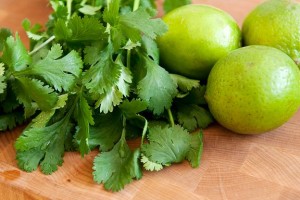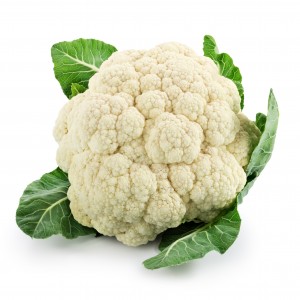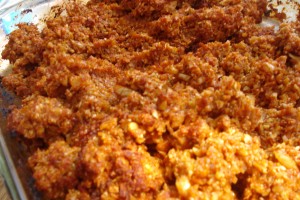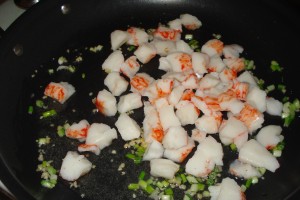I’ve found that one cauliflower can produce an awful lot of “rice,” especially when it’s on the medium to large side. Depending on the specific plant, I might get 8 or 9 cups of rice out of one head.  As a result, I’ve been splitting my “rice” and using the produce of one head for more than one recipe.
As a result, I’ve been splitting my “rice” and using the produce of one head for more than one recipe.
This past weekend, I made myself some favorite Thai-inspired dishes, Pumpkin Curry and Squ-oodles with Peanut Sauce. As an accompaniment to these two dishes, I riced my cauliflower and used the 8 cups of “rice” it produced to make two dishes.
SARAH’S CILANTRO LIME “RICE”
juice and zest of one lime
1 tablespoon oil
1/2 teaspoon salt
fresh ground pepper, to taste
2 tablespoons chopped cilantro or cilantro chutney
2 spring onions, chopped
4 cups cauliflower rice
Rice your cauliflower; fold in a clean kitchen towel and set aside.
Zest your lime, then juice it (fruit is easier to zest fully round, and easier to juice without the peel). Combine zest, juice, oil, salt, pepper, cilantro or chutney, and onions in a bowl. Add 4 cups of cauliflower rice and stir until the green ingredients are evenly distributed. Enjoy chilled as a salad, or warmed to eating temperature as a side dish.
This dish was pretty predictably delicious. It is, after all, very similar to the basic ingredients in my favorite coleslaw recipe. It was a perfect accompaniment to the curries.
SARAH’S COCONUT “RICE”1 tablespoon oil
1 medium onion, chopped fine
1 teaspoon minced garlic
1/2 cup white wine
7 oz coconut cream
4 cups cauliflower rice
salt & pepper, to taste
Rice your cauliflower; fold in a clean kitchen towel and set aside.
Heat the oil in a small saucepan. Saute the onion and garlic. Add the white wine and coconut cream. If your onion was not chopped small enough (my eyes are very sensitive to onion and I can only get a few cuts in before they burn so badly I can’t be in the same room with the onion), you may want to puree the sauce with an immersion blender as it thickens. Simmer, stirring often until reduced into a thick, almost tacky, sauce. Allow to cool; it should be close to room temperature before adding the cauliflower.
Stir in the cauliflower rice. Season to taste. Serve and enjoy.
This recipe was a bit trickier. It is based on the concept of coconut-cooked rice that Sabrina introduced to me. Essentially, she cooks rice in an equivalent amount of coconut milk to the amount of water usually required. It has the welcome effects of lowering the glycemic index and adding flavor. I’ve been wanting to do something similar with cauliflower rice for awhile. In fact, it was the first recipe I tried with cauliflower rice. The problem was that I treated the cauliflower rice like regular rice, and it ended up wet and slimy.
With my new-found cauliflower rice expertise, I realized that I had to keep the cauliflower raw and crispy in order for this recipe to work. The key here was taking the time to reduce the sauce. Too much liquid will make this dish runny or soupy. The sauce needs to be thick enough that it will stick to the cauliflower. That’s why I describe it as tacky, sort of like paste or glue. It is also important not to add the cauliflower when this sauce is still hot. The cauliflower will release a bit of liquid if you put it in a hot sauce, making it less than crisp and defeating — at least in part — your efforts at liquid reduction.
Having taken these precautions, I must say that the dish turned out wonderfully, just as I had hoped, a worthy substitute for Sabrina’s Coconut Rice.













